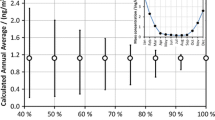Abstract
A review is given of methods being used to identify and interpret trends in air quality data from single stations and from networks of stations. Some comments are also included concerning the problem of designing networks which will identify trends as quickly as possible, thus providing early warnings of significant changes in air quality.
Similar content being viewed by others
References
CraddockJ. M.: 1957, ‘A Simple Statistical Test for Use in the Study of Climatic Change’,Weather 12, 252–258.
BoxG. E. P. and JenkinsG. M.: 1976,Time Series Analysis, Forecasting and Control (2nd edition), Holden-Day, San Francisco, 575 pp.
TiaoG. C., BoxG. E. P., and HammingW. J.: 1975, ‘A Statistical Aanalysis of the Los Angeles Ambient Carbon Monoxide Data 1955–1972’,J. Air Poll. Control Assoc. 25, 1129–1136.
CampbellJ. (Ed.): 1978,Proc. NASA-Sponsored Symp. on Ozone Trend Detectability, Boulder, Col. (July, 1977), 84 pp. (available from Dr. J. Campbell, NASA Langley Res. Center, Hampton, Va.).
HillW. J. and SheldonP.N.: 1975, ‘Statistical Modelling of Total Ozone Measurements with an Example Using Data from Arosa, Switzerland’,Geophys. Res. Letters 2, 541–544.
PittockA. B.: 1972, ‘Evaluating the Risk to Society from the SST: Some Thoughts Occasioned by the AAS Report’,Search 3, 285–289.
PittockA. B.: 1974, ‘Ozone Climatology, Trends and the Monitoring Problem’, In:Proc. Int. Conf. on Structure, Composition and General Circulation of the Upper and Lower Atmospheres and Possible Anthropogenic Perturbations, Vol. I, pp. 455–466 (available from Dr. S. Ruttenberg, NCAR, Boulder, Col.).
KarolI. L., PolyakI. I., and VinnikovK. Ya.: 1976, ‘Statistically Correct Determination of Long-Period Trends in Geophysical Data Series’,Pageoph. 114, 965–974.
MunnR. E. and RodheH.: 1971, ‘On the Meteorological Interpretation of the Chemical Composition of Monthly Precipitation Samples’,Tellus 23, 1–13.
PittockA. B.: 1977, ‘On the Causes of Local Climatic Anomalies, with Special Reference to Precipitation in Washington State’,J. Appl. Meteorol. 16, 223–230.
MunnR. E.: 1969, ‘Pollution Wind-Rose Analysis’,Atmosphere 7, 97–105.
HillW. J., SheldonP. N., and TiedeJ. J.: 1977, ‘Analyzing Worldwide Total Ozone for Trends’,Geophys. Res. Letters 4, 21–24.
PrinnR. G., AlyeaF. N., and CunnoldD. M.: 1976, ‘The Impact of Stratospheric Variability on Measurement Programs for Minor Constituents’,Bull. Am. Meteorol. Soc. 57, 685–694.
MunnR. E.: 1980,The Design of Air Quality Monitoring Networks, Macmillan Press Ltd., Basingstoke, Hampshire, U.K. (in press).
MahlmanJ. D., LevyH., and MaximW. J.: 1978, ‘Simulation of the Three-Dimensional Structure and Variability of Atmospheric N2O’. In Preprint Vol.WMO Symp. on Geophys. Aspects and Consequences of Changes in Composition of Stratosphere, WMO Geneva, p. 215.
MaximW. J. and MahlmanJ. D.: 1978, ‘Evaluation of Various Total Ozone Sampling Networks Using the GFDL 3-D Tracer Model’. In Preprint Vol.WMO Symp. on Geophys. Aspects and Consequences of Changes in Composition of Stratosphere, WMO Geneva, p. 217.
Author information
Authors and Affiliations
Additional information
Reprinted from the Preprint Volume, WMO Technical Conference on Regional and Global Observation of Atmospheric Pollution Relative to Climate, Boulder, Col., Aug. 1979, WMO Geneva, No. 549.
Rights and permissions
About this article
Cite this article
Munn, R.E. The estimation and interpretation of air quality trends, including some implications for network design. Environ Monit Assess 1, 49–58 (1981). https://doi.org/10.1007/BF00836875
Issue Date:
DOI: https://doi.org/10.1007/BF00836875




